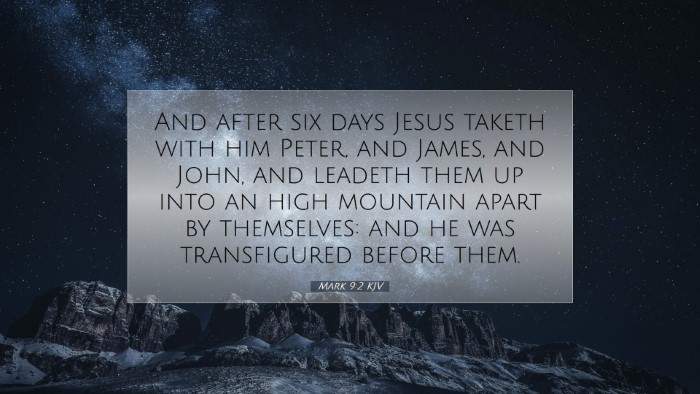Commentary on Mark 9:2
Bible Verse: "And after six days Jesus taketh with him Peter, and James, and John, and leadeth them up into a high mountain apart by themselves: and he was transfigured before them." (Mark 9:2)
Introduction
The event described in Mark 9:2 is one of the most significant moments in the Synoptic Gospels, where Jesus reveals His divine glory to a select group of disciples. This moment is pivotal for understanding the nature of Christ, affirming His divine sonship, and preparing the disciples for the suffering that lies ahead.
Contextual Analysis
This verse follows Jesus’ teaching about discipleship and His prophecy regarding His death and resurrection. The "six days" mentioned serves not only as a temporal marker but also hints at the importance of the event that is about to unfold. In biblical terms, the number six often represents incompleteness, suggesting that the fullness of revelation is about to be revealed.
Exegesis
According to Matthew Henry, the selection of Peter, James, and John signifies a specific intention by Jesus to reveal deeper truths to those who were closest to him. This intimate circle of disciples provides a necessary balance of leadership and faith, as they would later take on pivotal roles in the early church.
Albert Barnes emphasizes that the mountain symbolizes a place of revelation and communion with God, reminiscent of Moses on Mount Sinai. By leading them “up into a high mountain apart by themselves,” Jesus creates a sacred space where physical elevation correlates with spiritual elevation, indicating a move from the earthly experience to divine revelation.
In the observations of Adam Clarke, the element of being "transfigured" is critical. He notes that the Greek term used implies a transformation that reveals Christ’s true nature, showcasing not just external change but an unveiling of His inner glory.
Theological Insights
This passage serves multiple theological purposes:
- Divine Glory Revealed: The transfiguration reveals the divine nature of Christ. The brilliant light surrounding Him signifies His purity and holiness, drawing a stark contrast with the darkness of human sin.
- Affirmation of Faith: For the disciples, witnessing the transfiguration reaffirms their faith in Jesus as the Messiah. It strengthens their understanding of His impending suffering and glorification, serving as a precursor to the resurrection.
- Preparation for Ministry: This event prepares the disciples not only to witness His glory but also to endure Jesus’ sufferings, emphasizing the dual nature of their following and the cost of discipleship.
Application for Believers
The transfiguration encourages believers to seek moments of communion with God, much like the disciples experienced on that mountain. The call to draw aside from the pressures and distractions of life to experience God’s presence is timeless and relevant in the life of every Christian.
Additionally, it challenges believers to recognize Christ’s glory in their lives and circumstances, transforming their perspectives as they confront trials and suffering with the hope of His eternal kingdom.
Conclusion
Mark 9:2 is dense with meaning and rich in implications for theology and practice. The transfiguration stands as a significant moment of divine revelation, encouraging both present and future generations to understand the majesty of Christ and the transformative power of His presence. Studying this passage, we are compelled to lean into the sacred experiences of our faith, expecting how God reveals Himself anew in our lives.


